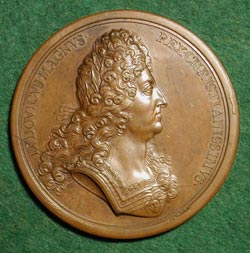

|
CAPTURE OF LUXEMBURG ROETTIERS, Joseph / MOLART, Michel: France, 1684, Bronze,
70 mm To further the ambitions of Louis XIV to expand his territories into the Spanish Netherlands, in1681 French troops occupied Strasbourg and seized Casale. Thus, two of the places which were deemed essential for Louis' ambitions had fallen into his hands; it only remained to occupy Luxemburg, in order to make France practical mistress of the Netherlands. To achieve his goals Louis had owed much of his success to the neutrality of England. Charles II had consistently refused to unite with William of Orange and Spain in checking the French aggressions on the northeastern and eastern frontiers. Louis was thus freed from all fear of an attack on his flank, which enabled him to concentrate all his attention upon his aggressive schemes with regard to Germany and the Spanish Netherlands. The sole chance of successfully resisting these schemes lay in a close alliance between England and the continental enemies of the French King. Charles II had thus facilitated the execution of several of Louis' most important designs. Following intrigues and battles in the defense of Christian Europe, involving the Turks, the Holy Roman Empire, and indeed much of Europe, the Spaniards, in 1683, declared war against France, giving Louis the final excuse to invade Luxemburg. It was impossible for the Emperor, with the Turkish War on his hands, to oppose the French successfully. Luxemburg was besieged by the French troops, and was taken on June 7, 1684, the event commemorated by this medal. (from www.uni-mannheim.de) |
|